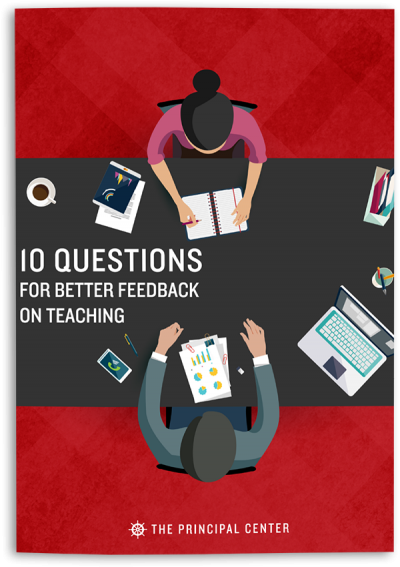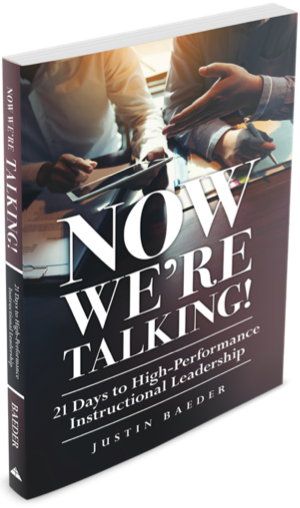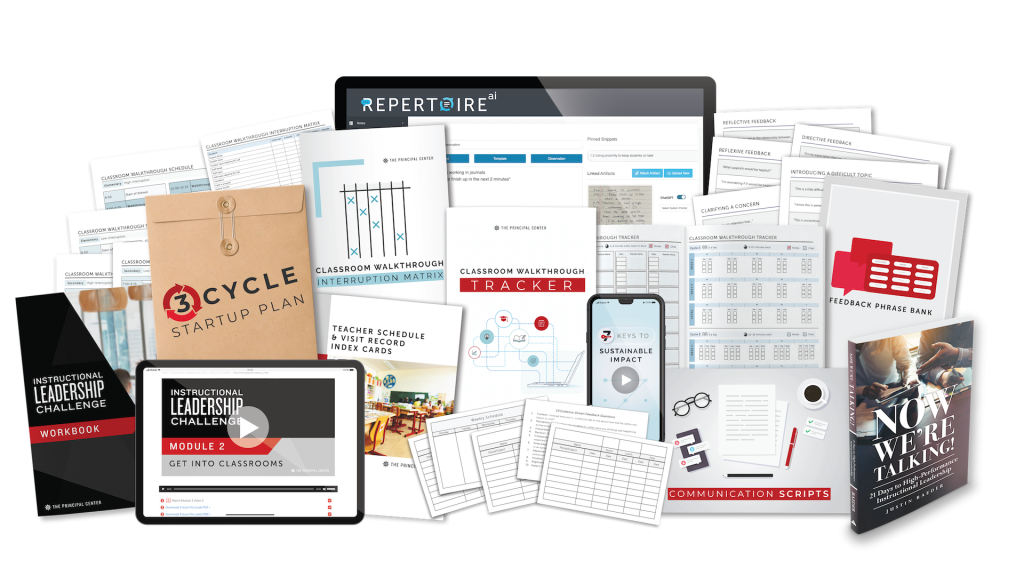Leaders don't just give suggestions—they can play three distinct roles in helping teachers improve. Here's how to differentiate your leadership based on each teacher's needs.
by Justin Baeder, PhD

What can instructional leaders do to actually change teacher practice?
Changing practice starts with getting into classrooms and having conversations with teachers.
Office-based activities like analyzing data and planning professional development are important, but they're no substitute for actually seeing teachers at work, and talking with them about their work.
My book Now We're Talking! 21 Days to High-Performance Instructional Leadership is all about making a daily habit of classroom visits.
But what do we do when we get there?
For most school leaders, the answer is feedback.
We know we're supposed to provide feedback…but how is feedback actually supposed to work? And what kinds of feedback should we provide?
When we talk about feedback, we're usually thinking of directive feedback and reflective feedback.
In any given conversation, we want to either change the teacher's behavior, or help them change their thinking.
With a teacher who is struggling, we might take a more directive stance and play the boss:
“You must not raise your voice or yell at students. Instead of yelling, use a consistent signal to get everyone's attention, then give directions in a normal speaking voice.”
It would be a waste of time to ask reflective questions when you already know what you want the teacher to do. No need to play games and make the teacher guess what you're thinking.
But often, the teacher's behavior is fine. It's their thinking—the cognition and decision-making behind their actions—that you want to help improve.
So you might play the coach ask a reflective question:
“I noticed that you asked a series of questions during the discussion that gradually moved to the higher levels of Bloom's Taxonomy. What are some ways you get students to start asking these higher-order questions, so they can take more leadership in directing class discussions?”
Because teaching is complex professional work, we can't make teachers' decisions for them. Relying on directive feedback with highly skilled teachers is a recipe for disaster.
But by asking the right questions at the right time, we can prompt the kinds of thinking that can help teachers improve their practice.
So these two roles are a core part of most instructional leaders' practice:
- The “boss” who uses directive feedback to improve teacher behavior, and
- The “coach” who uses reflective feedback to change teacher thinking
But there's a problem with these two roles: they aren't enough.
A brief observation usually doesn't provide enough information to have a high-quality directive or reflective feedback conversation.
When we try to jump into directive or reflective feedback without enough information, something feels “off.”
We trigger the teacher's resistance, or our own. The higher the level of resistance, the more we hesitate to get into classrooms.
So we know we need to be doing something differently…but we're not sure quite what it is.
Too often, this confusion about our precise role as instructional leaders—how we change teacher practice—keeps us from taking any action at all.
So the norm in our profession is for administrators to spend very little time in classrooms—at least, very little substantive time, beyond the required formal observations.
We can do much better, but first, we must understand precisely how the “boss” and “coach” roles function, so we can fill in the gaps.
The Boss Role: Changing Teacher Behavior with Directive Feedback
To help us think about the way teachers respond to directive feedback, let's consider the way we view advice from our doctors.
When you go to the doctor and get medical advice…why do you trust that advice?
Trust is essential, because if you go to the doctor but don't do what your doctor prescribes, your health won't improve.
All the prescriptions in the world won't help if you don't take your medicine…and often we feel like our struggling teachers just aren't taking their medicine.
We know what they need to do…so why won't they do it? Why do teachers resist directive feedback, and how can we increase our odds of success?
When your doctor prescribes a medication, or recommends a procedure…why do you take their recommendations seriously?
Three main reasons come to mind.
First, there's expertise. You expect that your doctor has been to medical school and developed a deep knowledge of:
- The various types of injuries, illnesses and diseases
- How to make a proper diagnosis
- The various treatment and medication options
- How to decide what kind of care is best for a given patient
But you also want your doctor to know you. So in addition to expertise, firsthand knowledge matters.
It's not enough to know about medicine in general—you also want your doctor to know about YOUR personal medical history. A medication that's perfect for one patient may be harmful to another patient, even if they have the same symptoms. The details of each individual case matter.
Third, you expect your doctor to listen to your complaint, and to ask questions that will help you describe the situation more clearly, so you can get an accurate diagnosis and prescription.
Listening is at the heart of strong relationships. According to the New York Times, the biggest cause of malpractice lawsuits against doctors is poor communication.
Similarly, the biggest reason we fail to change teacher behavior—even when we know exactly what needs to change—is a failure to listen.
These are the conditions for getting the professional treatment one needs to get better—and the same conditions hold whether we're at the doctor or in the classroom. We need:
- Expertise
- Firsthand knowledge
- Listening
As leaders, if we're going to tell teachers how to improve, we first need to have expertise.
But instructional expertise isn't enough. We also need to know the person we're working with—their strengths, weaknesses, and current situation.
In order to make an accurate diagnosis and give an accurate prescription of what needs to happen next, we need to know the individual case in detail, and that means we need to listen.
Even when we're working with teachers who are making serious and obvious mistakes—like failing to plan lessons, or screaming at students—we need to have expertise, gain firsthand knowledge, and listen.
The best way to accomplish all three of these requirements is to spend time observing and talking with the teacher.
Once- or twice-annual formal observations aren't enough. The more time you spend in each teacher's classroom, the more you'll be able to provide accurate and helpful directive feedback to teachers who are struggling.
Want to get into classrooms daily? Take the Instructional Leadership Challenge »
But what if teachers resist directive feedback? What if a teacher needs to make obvious and immediate changes to their practice, but refuses?
Overcoming Direct Resistance to Directive Feedback
I once supervised a teacher who wasn't planning his math lessons in advance—he'd just wing it, every single day.
When I discovered what was happening, I was fairly direct:
“This is not working. You need to plan in advance. You cannot read out of the teacher's guide during class without any planning ahead of time. You need to plan and prepare in advance so your students can learn.”
I was 100% right in diagnosing the problem and prescribing the solution. But accurate information wasn't enough to change his practice, because he resisted, head-on. He said:
“Actually, I don't really think I need to change the way I plan. So, no—I'm not doing that. In fact, I don't really want you to come in my classroom. I've got this under control. Just leave me alone—you do your job, and I'll do mine.”
He called the teacher's union, and just as quickly, I called my supervisor. Both the union rep and my boss backed me immediately—which, as a young principal, I greatly appreciated.
Direct resistance is usually best handled directly—with clear expectations, and clear role definitions.
Once he understood my expectations, and that they weren't optional, he made the necessary changes.
Positional power isn't the only way to overcome direct resistance, but sometimes it's the right approach.
In other cases, though, resistance comes not from a bad attitude on the teacher's part, but from a mistake we make as leaders: giving directive feedback to professional teachers who can only grow if we take more of a coaching stance.
And sometimes, we need to play both roles at different times for the same teacher. Once the teacher above accepted the fact that he needed to do lesson plans, I could play a coaching role in helping him develop effective lesson plans.
It wouldn't have worked for me to write his lesson plans. That was his job as a professional—and my job as an instructional leader was to help him get better at it.
The more frequently you observe and talk with each teacher, the more clearly you'll know when it's time to set the “boss” role aside, and start to take a coaching stance.
The Coach Role: Changing Teacher Thinking with Reflective Feedback
When I became a principal, I didn't have great expertise in elementary instruction, because I had been a middle school science teacher. I had never taught primary reading or math.
I could give directive feedback if a teacher was struggling with the basics, but what about stronger teachers? What if they needed ultra-specific feedback in an area I knew nothing about? How could I help a 25-year veteran Kindergarten teacher improve her 1:1 reading conferences?
Because I didn't have expertise, I couldn't diagnose and prescribe appropriate next steps for teachers who were already doing well.
So what did I do?
I didn't try to tell teachers what they did right and what they did wrong. Instead, I asked open-ended softball questions like:
- “Tell me more about when you did ___…”
- “What were your goals for the lesson?”
- “What are you thinking you'll do next?”
I was worried that this would undermine my credibility. After all, what kind of doctor asks the patient
“So…what medication do you think I should prescribe for you?”
And sure enough, teachers did start to catch on. They realized that they could end the conversation quickly if they played the game.
Overcoming Indirect Resistance to Reflective Feedback
Indirect resistance often takes the form of what I call the Fake Feedback Game.
In this game, there are two players: the administrator, and the teacher. The rules are simple:
- The administrator must pretend to provide feedback, and
- The teacher must pretend to appreciate it,
- They both must pretend teacher practice has changed as a result of the conversation
I was pretending to “provide feedback” with my softball questions, because I didn't really know what else to say:
“Oh, so you were trying to use higher-order questions in your discussion today? Great! I wonder if… you might use more analysis and synthesis questions with ELL students? Maybe…?”
I'd hope and pray the teacher wouldn't disagree or call me out on my softball questions.
Teachers knew the fastest way to get rid of me was to smile and nod and play along:
“Oh yeah, great point, Justin! I will definitely work on that and let you know how it goes, OK? Bye!”
When we play the game, the teacher's practice doesn't change.
But there's a bigger problem—I don't know any more than I did before I walked into the classroom:
- I don't know if my feedback was helpful
- I don't know if the teacher will act on it
- I didn't learn anything I can use to help other teachers improve
- I didn't learn anything I can use to improve my school overall
When it comes to improving our schools overall, we need good information to make good decisions.
If all we're seeing is teachers who are doing OK and enthusiastically agreeing with all of our feedback, we won't discover our best opportunities for improving teaching and learning.
Fortunately, I had a great staff, and we developed great relationships pretty quickly, so I ended up not playing the Fake Feedback Game very much.
I'm incredibly grateful to the teachers who trusted me enough to be completely honest about what they were working on, how it was going, and what they thought they—and the school—needed to do next to improve.
It was through these conversations that I discovered the true reason it's so hard to change teacher practice.
And I discovered that neither the “boss” nor the “coach” roles would take us where we needed to go.
Seeing the Whole Iceberg of Teacher Practice
When we get into classrooms, it's essential to recognize that we're not seeing everything.
Like an iceberg, most of teachers' practice is hidden beneath the surface.

I would suggest that the ratio is about 90/10—that is, only about 10% of teaching and teacher practice can be seen when we visit a classroom.
We're not seeing:
- The training and experience that shapes the teacher's judgment
- What happened yesterday, and what's in the rest of the unit plan
- The teacher's knowledge of, and relationship with, each individual student
- Connections between concepts in the curriculum that we may not know about
We absolutely need to get into classrooms, but we shouldn't deceive ourselves into thinking that we're seeing the whole of teacher practice.
When we get into a classroom, we can see what the teacher is doing and saying. We can see how they're acting. We can see what students are doing and saying.
We can take note of the resources they're using, we can get a feel for the learning environment, but we must never forget that there's also much that we can't see.
When we fail to see “the whole iceberg” of teacher practice, we tend to focus on just the parts we can see—the easily observable behaviors, such as whether the teacher is writing the objective on the board every day.
Trying to change your school by focusing only on observable teacher behaviors is exhausting and futile.
You can solve blatantly obvious problems by focusing on teacher behavior, but to take teachers from good to great, consistently and at scale, you must focus on teacher thinking.
Teacher behavior is like the tip of the iceberg, and teacher thinking is what's beneath the surface.
Thinking is largely invisible…until we make it visible through conversation.
There's no way to see what happened yesterday or five minutes ago. We can't see what will happen tomorrow, or even five minutes after we leave.
But we can ask—and it turns out that asking is remarkably simple, and remarkably effective.
If you want to understand teacher thinking and decision-making, just ask.
But here's a lesson I learned the hard way: don't ask “Why?” questions.
When you ask “Why” questions, you get justifications.
And using evidence to ask “why” questions only triggers more defensiveness, which doesn't lead to growth.
If—like me—you've spent countless hours in conversations that seem to go nowhere, you know just how unproductive these conversations become when we trigger teachers' defensiveness.
When you instead ask “how?” questions, you'll discover what you need to learn to lead effectively.
The more I asked “how?” questions—out of genuine ignorance at first—the more I learned that I needed an entirely new approach to feedback if I really wanted to change teacher practice.
The Leader Role: Shifting the Iceberg with Reflexive Feedback
Why does our feedback so often fail to change teacher practice?
When we take responsibility as instructional leaders, we can't just say “Well, I gave them feedback, but they aren't changing.“
That's like the teacher who says “Well, I taught them, but they didn't learn.“
If we're leading, but no one is following…we're not leading!
Our leadership must be differentiated if we truly want to change teacher practice:
- To deal with direct resistance, and change teacher behavior, we must play the boss and use directive feedback
- To deal with indirect resistance, and change teacher thinking, we must play the coach and use reflective feedback
But teachers don't change their practice in a vacuum. So if we truly want to take responsibility, we must address the system within which teachers work.
Too often, when we try to change teacher practice, we focus only on the individual teacher. We try to change either the teachers’ actions or their thinking, but all of that occurs in a system—in a context that can't be ignored.
We must see the whole iceberg of practice—what's above and below the surface—but the current the iceberg is floating in matters even more.
W. Edwards Deming, who’s known as the father of the Quality Management movement, put it this way:
“In my experience most troubles and most possibilities for improvement add up to the proportions something like this: 94% belong to the system.”
So there's a third kind of feedback, which I call reflexive feedback, that gives us the greatest opportunity for improving our schools, because it gives us the feedback we need to improve the system.
To improve the system teachers work within, we must play the leader and use reflexive feedback.
Reflexive feedback conversations involve both parties in talking, listening, reflecting, and taking action. The idea of reflexivity, which comes from the social sciences, suggests a two-way street—a feedback relationship that runs in both directions.
Leaders who use reflexive feedback are more effective at changing teacher practice because they're willing and able change things other than the teacher, in order to support positive changes in the teacher’s practice.
Teachers who are engaged in reflexive feedback know they have a voice, and that their feedback to leaders will be taken seriously. As a result, they're more willing to invest effort in making changes to their practice—because they believe they'll get the support they need.
Reflexive feedback is what distinguishes leaders from coaches.
When I was a principal, I had a supervisor, and I also had a coach, and I had many great conversations with both of them. My coach was extremely helpful in getting me to reflect, and I know I got better as a result.
My supervisors did that too, but also did something else: they listened, and brought about changes in the district that would make me a more effective leader. So when we talked about a problem, I knew I’d have to do my part, but I also knew my boss would go to bat for me at the district office and get things done.
And that’s what we need to do, almost all of the time, when we’re working with teachers. There’s part they need to do to get better, but there’s also part we need to do as leaders.
Deming realized that, for too long, American companies tried to improve manufacturing by basically yelling at their workers and telling them to try harder.
Work faster! Produce more! Be safer! Have fewer accidents!
How did it work? Not very well. Blaming the front-line employee for factors beyond his or her control doesn't get us very far.
Deming realized that the next level of productivity wasn't about fixing the individual worker.
It wasn't that American workers were lazier or less careful than workers in other countries. The difference was that, in organizations that were improving rapidly, the focus was on improving their systems—not on individuals.
I believe it's time for us to learn the same lesson in education.
Teachers don't teach in a vacuum—they teach in a specific organization. The system they're working within determines the majority of the results that they get.
So if you want to take your school from good to great, it's not enough to address each individual “iceberg” of teacher practice. You're responsible for the current that moves the entire ocean.
As a new principal, when I got into classrooms, I often didn't know what to say, so I just listened and asked questions that would to tell me what I needed to know.
When I talked with teachers and learned what was going on beneath the surface of their practice—and what was going on within our school that might be hidden to me—I started to see my school as a system.
Once I saw the whole system, I was able to make better decisions:
- Decisions about what to address in professional development
- Decisions about who to hire to add to our team
- Decisions about how to allocate our budget
- Decisions about where to spend my time and attention
Having these conversations isn't difficult—and in any conversation, you can shift between directive, reflective, and reflexive feedback as needed.
To summarize:
Three Roles Leaders Play in Changing Teacher Practice
- The boss role helps you deal effectively with direct resistance and change teacher behavior through directive feedback.
- The coach role helps you deal with indirect resistance and change teacher thinking through reflective feedback.
- The leader role helps you change the system teachers work within through reflexive feedback.
As I explain in Chapter 2 of Now We're Talking! 21 Days to High-Performance Instructional Leadership, the best classroom visits have seven key features:
- Frequent—Approximately once every two weeks
- Brief—Five to ten minutes of observation, followed by a brief conversation
- Substantive—More than just making an appearance
- Open ended—Focused on the teacher’s thinking, not filling out a form
- Evidence based—Centered on what actually happened during the observation
- Criterion referenced—Linked to a shared instructional framework
- Conversation oriented—Designed to lead to reflexive feedback conversations between teachers and instructional leaders
For ten evidence-based questions to structure your conversations with teachers, download the free PDF guide, 10 Questions For Better Feedback On Teaching

Have other questions? Leave a comment.
Leave a comment below if you have other questions about instructional leadership.
About the Author

Justin Baeder, PhD is Director of The Principal Center, where he helps senior leaders in K-12 organizations build capacity for instructional leadership.
A former principal in Seattle Public Schools, he is creator of the Instructional Leadership Challenge, which has helped more than 10,000 school leaders in 50 countries around the world:
- Confidently get into classrooms every day
- Have feedback conversations that change teacher practice
- Discover their best opportunities for school improvement
Dr. Baeder is the author of Now We're Talking! 21 Days to High-Performance Instructional Leadership, and the co-author, with Heather Bell-Williams, of Mapping Professional Practice: How to Develop Instructional Frameworks to Support Teacher Growth (Solution Tree).
He is the host of Principal Center Radio, a podcast featuring education thought leaders, and the founder of Repertoire, the professional writing app for instructional leaders.
He holds a PhD in Educational Leadership & Policy Studies from the University of Washington and an MEd in Curriculum & Instruction from Seattle University, and is a graduate of the Danforth Program for Educational Leadership at UW.


